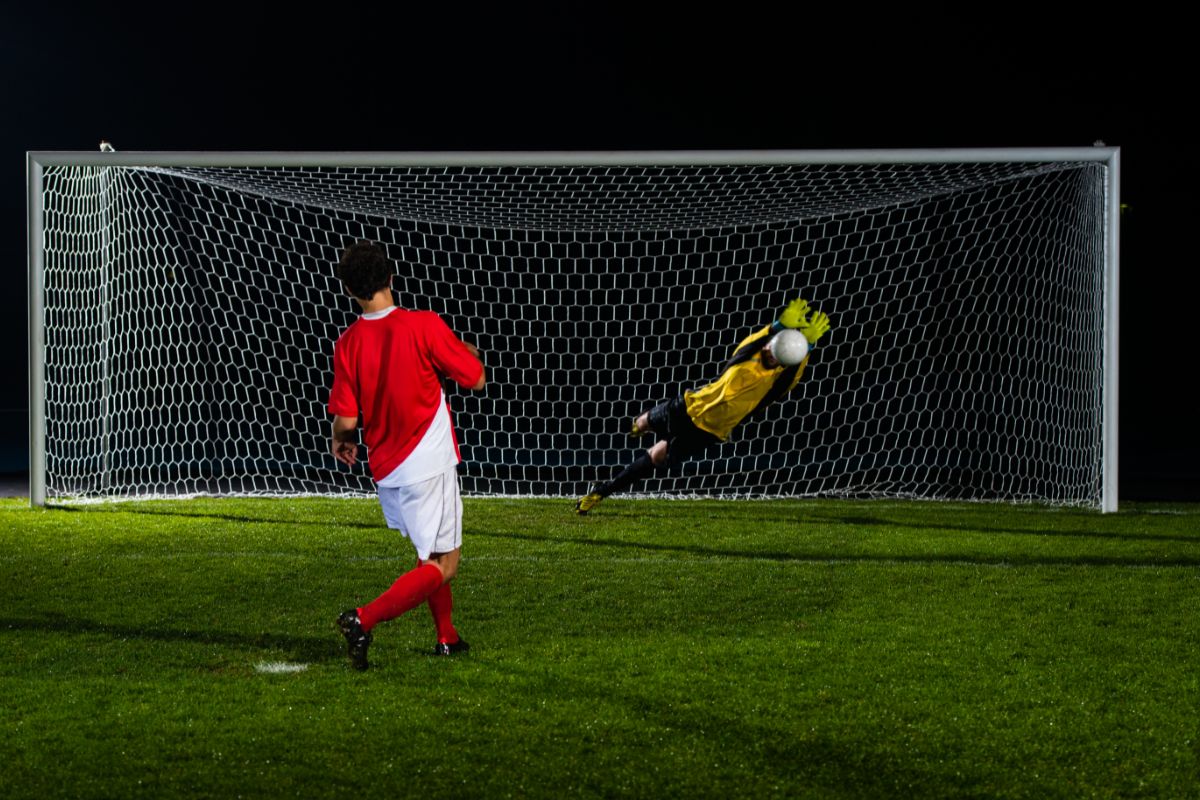Standard Soccer Goal Width
Watching soccer on TV is all well and good but it can be difficult to get an accurate understanding of the scale at which the game takes place.
Many young soccer fans are amazed the first time they visit a professional soccer team’s stadium because of how much bigger it is in person. The same is also true of the rest of the soccer field and you might be surprised by how big the goals are.
The standard size for a goal in soccer, according to FIFA regulations, is 8 yards (7.32 meters) in width and 8 feet (2.44 meters) in height.
However, you may also be surprised to learn that not all goals in soccer have to conform to this size. In fact, there are plenty of rules at different levels of the sport about the shape, size, and dimensions of the goal.
Youth Soccer Goal Sizes
The 8 yards by 8 feet measurement is applied only to senior games of soccer, played between adults. However, when smaller children play soccer, they use significantly smaller goals to make the game fairer.
There are no universal regulations about appropriate goal sizes for youth soccer because the size and ability level of the players can vary so much between age groups. However, each competition organizer will make recommendations about the appropriate goal sizes for each age group.
To get a clearer understanding of how different youth soccer goals can be from senior ones, here are the US Youth Soccer recommendations for goal dimensions at different ages:
- U6/U7/U8 – 4’ x 6’
- U9/U10 – 6’6” x 18’6”
- U11/U12 – 7’ x 21’
- U13 and above – 8’ x 24’
The number of players on the field, the size of the playing area itself, and the size of the goals go up as the age of youth players increases.
These regulations ensure that the competitions are always fair, regardless of the ages of the players.
FIFA Regulations Regarding Goals
FIFA, the governing body for all international soccer, publishes a document every season called ‘the laws of the game’.
The laws of the game dictate the official standard regulations for soccer in all FIFA-organized competitions and they’re generally considered to be the international standard for the sport.
We’ve already established that the official FIFA-regulated goal dimensions are 8 yards by 8 feet but what else is said about the goal.
Goal Frame Color
One thing FIFA is adamant about regarding the goal is that the vertical posts and horizontal crossbar must be painted white.
Goal Frame Shape
This might seem confusing, but FIFA also has specific regulations about what shape the posts and crossbar of the goal should be.
The goalposts and crossbars can be made up of poles with the following shapes:
- Circle
- Oval
- Rectangle
- Square
According to FIFA, the width of the actual posts themselves should not be more than 5 inches (12 centimeters). Of course, the frame of the goal itself must always be rectangular when entirely constructed. Then, the dimensions of the goal frame must follow the competition rules we outlined previously.
Goal Frame Material
As you might expect, the materials that can be used for constructing goal frames are also decided by FIFA. They state that goal frames must be made from wood, metal, or another approved material.
The majority of professional soccer teams use goal frames made out of metal because it is sturdy, durable, very unlikely to get misshapen over time, and require less maintenance than wood.
Soccer Goal Nets

There aren’t quite as many regulations in the laws of the game about the net of the goal. Quite simply, there has to be a net secured to the goal so that there are no holes where the ball could pass through. It must also be properly supported so that it doesn’t interfere with the goalkeeper.
Aside from this, teams can use whatever design, style, and color they want.
This does lead some teams to come up with some pretty cool designs and you’ll often find the color of the net matches the color of the home team’s kit. Check out this example of the German side, Borussia Dortmund’s, net, which matches the team’s uniform colors.
The reason that a net is necessary for a goal in soccer is to help out the officials and the players to tell when a goal has been scored.
Depending on the angle you see a goal scored from, you might not be able to tell whether or not it has gone through the frame of the goal or just to the side of it. If the ball ends up in the net after crossing the goal line, there can be no questions that the goal has been scored legally.
The only time this isn’t the case is when a hole in the net causes the ball to go through the side, making it look like a goal has been scored legally.
Check out this example from the German first division.
Final Thoughts
Hopefully, you’ve enjoyed learning everything there is to know about goals in soccer. Everything we’ve looked at in this article needs to be thought about carefully by the groundskeepers at soccer stadia all over the world, as well as soccer competition organizers.
The 8-yard width is a universal requirement for all professional soccer competitions that FIFA is involved with. In fact, because it’s such a standard measurement that the whole world agrees on, you’ll probably find this goal width in absolutely any kind of soccer competition, regardless of whether FIFA is involved.
If you think about how big the goals in soccer really are, you can get a real sense of how hard the goalkeepers have to work to keep the ball out. Bear that in mind next time you see your team concede on TV!




0 Responses